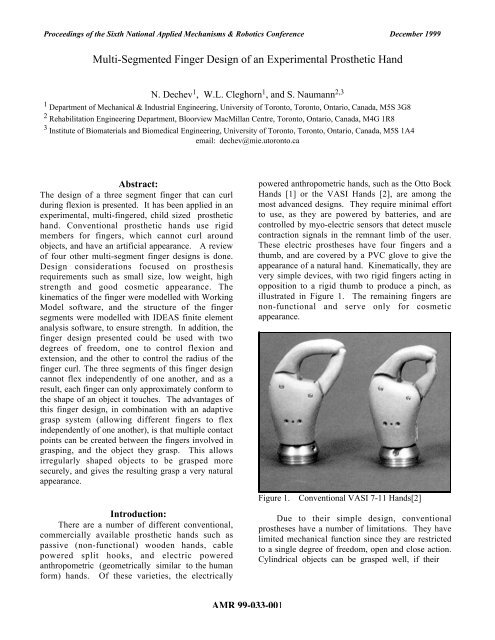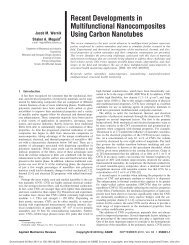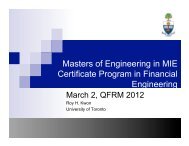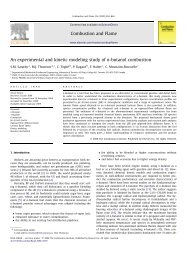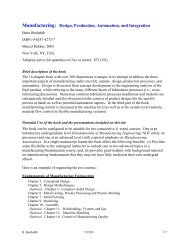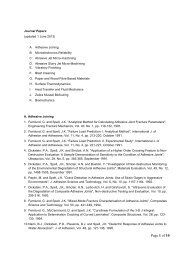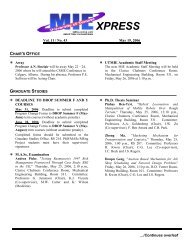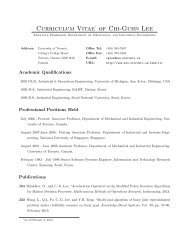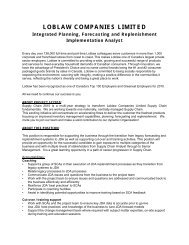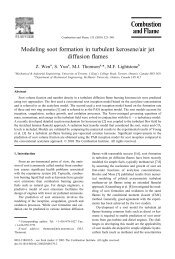Multi-Segmented Finger Design of an Experimental Prosthetic Hand
Multi-Segmented Finger Design of an Experimental Prosthetic Hand
Multi-Segmented Finger Design of an Experimental Prosthetic Hand
You also want an ePaper? Increase the reach of your titles
YUMPU automatically turns print PDFs into web optimized ePapers that Google loves.
Jungov seminar o Ničeovom Zaratustritoliko poplavila da ne možete preći preko i morate čekati neđeljama;možete čak i umrijeti od gladi ako ste uhvaćeni izmeđudvije rijeke. I nije rijeka opasna samo zbog poplava već i zboggaženja preko vode ili njenog premošćiv<strong>an</strong>ja, gotovo ste sigurnida upadate u neugodnu situaciju. Svakako, taj strah ovđe nemasmisla uopšte za duže vrijeme, ali je tada bio mnogo značaj<strong>an</strong>.Sasvim neočekiv<strong>an</strong>o, recimo, uđete u rijeku četrdeset ili pedesetjardi široku, nasipi su prilično strmi, ona vrvi od krokodila takoda nema pliv<strong>an</strong>ja; nosite sav teret preko i dođavola, nepokretniste. Vjerovatno lutate duž obala satima i satima da pronađete gazđe ćete m<strong>an</strong>je ili više bezbjedno preći. Ili je možda palo drvo ilije pośečeno od urođenika tako da je palo preko rijeke i ako jevrijeme vedro možete biti sposobni da puzite preko vrlo t<strong>an</strong>kogdrveta, prvo preko korijena i debla, a zatim kroz gr<strong>an</strong>e i onda sečudite kako sav teret možete prenijeti preko, iako je po kišnomvremenu ono svakako pakleno klizavo. Ali, bez najneznatnijihočekiv<strong>an</strong>je nađete se u poziciji u kojoj ste bolje postupili negošto ste željeli. To je savršeno šašavo, čovjek je bio u nekojsasvim ugodnoj situaciji prije i onda se iznenada nađe u opasnostida se pokliza s drveta. I niko vas ne može zadržati jer nepostoji soba, prelazite preko ako možete, a petnaest ili dvadesetstopa niže su krokodili koji čekaju svoj doručak.Dakle, to je arhetipska situacija koja se pojavila nebrojenoputa, ako to baš nijesu krokodili, postoje neprijatelji koji čekajuda vas uhvate kad ste u vodi savršeno bespomoćni. Dakle, pretpostavljase za gazove, teške prelaze i takva mjesta da su naseljenazmajevima i zmijama, postoje čudovišta u dubokim vodama,neprijatelji u šumama, iza stijena i tako dalje. Zato je gaženjepreko rijeke tipična situacija koja izražava vrstu ćorsokakatako da je arhetip baš formulis<strong>an</strong> kad je čovjek u nekoj opasnojteškoći, i zato mnogi ljudi postaju sasvim nepotrebno arhetipskiuplašeni, uhvtio ih je najneopravd<strong>an</strong>iji strah. Čovjek može rećida ne postoji opasnost - zašto vam đavo ne daje da idete naprijed?Ali, oni su uplašeni da pređu čak i mali potok. Ili to može192 MATICA, zima 2009. www. maticacrnogorska.me
Proceedings <strong>of</strong> the Sixth National Applied Mech<strong>an</strong>isms & Robotics Conference December 1999phal<strong>an</strong>x link <strong>an</strong>d the medial phal<strong>an</strong>x link. It isattached at a point on the distal phal<strong>an</strong>x link. Tooperate the finger, the cable is drawn back via <strong>an</strong>actuator, through the tube rigidly linked to the palm,causing the finger to flex closed. When grasping alarge object in a power grip, this design worksreasonably well.However, there are some major problems withthis design. The first is that this finger design is notappropriate for precision grasps involving finger tip<strong>an</strong>d thumb tip contact (bi-digital pinch), because thefinger becomes unstable. Working Model 2Dsimulations <strong>of</strong> the bi-digital pinch confirmed theinstability. Upon formation <strong>of</strong> the bi-digital pinch,the medial interphal<strong>an</strong>geal joint would buckleinward, as shown in Figure 6, <strong>an</strong>d cause the pinch tocollapse. In the process <strong>of</strong> this collapse, the objectwithin the grasp would be ejected outwards.Figure 7. Cable <strong>Finger</strong> Tip TrajectoryObserve that the cable is attached to the distalphal<strong>an</strong>x, but only slides through the medial <strong>an</strong>dproximal phal<strong>an</strong>ges via the tubes. When tension isapplied to the cable, a torque is developed aroundjoint A <strong>an</strong>d the distal phal<strong>an</strong>x rotates, however, thecable does not tr<strong>an</strong>smit <strong>an</strong>y force to the medial orproximal phal<strong>an</strong>ges. Only when the distal phal<strong>an</strong>xfully flexes, c<strong>an</strong> the cable create a torque around jointB, <strong>an</strong>d later still around joint C.Finally, a minor disadv<strong>an</strong>tage is that the cabledesign needs springs to return the fingers to the openposition when the cable tension is relieved.Therefore, the cable finger design was ab<strong>an</strong>doneddue to its disadv<strong>an</strong>tages.Figure 6.Cable <strong>Finger</strong> Collapse During PinchThe second problem with this design is that thefingers would not close in a trajectory suitable forgrasping objects. This trajectory was also very noncosmeticin dynamic appear<strong>an</strong>ce. During fingerflexion, first the distal phal<strong>an</strong>x link would flex fully,then the medial phal<strong>an</strong>x link would flex somewhat,finally followed by the proximal phal<strong>an</strong>x link. Thisincorrect motion is shown in Figure 7. During theclose <strong>of</strong> a natural h<strong>an</strong>d, all <strong>of</strong> the phal<strong>an</strong>ges flexinward at the same time, with the proximal phal<strong>an</strong>xflexing through a greater <strong>an</strong>gle during the process. Inthis way, the natural h<strong>an</strong>d c<strong>an</strong> either pinch <strong>an</strong> object,or grasp <strong>an</strong> object <strong>an</strong>d continue to ‘wrap’ theremaining phal<strong>an</strong>ges around the object. The reasonfor the incorrect trajectory <strong>of</strong> the cable finger designc<strong>an</strong> best be explained with the use <strong>of</strong> Figure 7.The cable design was originally pursued afterinvestigation <strong>of</strong> a plastic toy robot h<strong>an</strong>d with flexingfingers. It is interesting to note that the cable fingerdesign will work under the special condition wherethe cable is semi-flexible, as was the case for this toy.The cable itself could be a thick nylon orpolypropylene tendon, such that when tension isapplied to it, the flexing <strong>of</strong> the tendon defines thefinger shape, not the phal<strong>an</strong>ges surrounding the cable.Because the tendon has ‘memory’ it returns to itsoriginal shape after the tension is released,eliminating the need for springs. The only drawback<strong>of</strong> this design is the great amount <strong>of</strong> energy that isneeded to const<strong>an</strong>tly flex this semi-rigid tendon.Such designs are currently being pursued by a groupin California[19].TWO D.O.F. RIGID LINK FINGERSThe single degree <strong>of</strong> freedom fingers that havebeen designed for the prototype h<strong>an</strong>d, as shown inAMR 99-033-005
Proceedings <strong>of</strong> the Sixth National Applied Mech<strong>an</strong>isms & Robotics Conference December 1999Figures 3 <strong>an</strong>d 4, c<strong>an</strong> be converted into two degree <strong>of</strong>freedom fingers quite easily. This was not done forthe prototype h<strong>an</strong>d due to space requirements <strong>an</strong>d theneed for a second actuator, but it is shown here todemonstrate the versatility <strong>of</strong> the rigid link design.One degree <strong>of</strong> freedom c<strong>an</strong> control the flexion <strong>an</strong>dextension <strong>of</strong> the finger as before, while the additionaldegree <strong>of</strong> freedom c<strong>an</strong> control the ‘curl’ or trajectory<strong>of</strong> the finger. This is achieved by greater control <strong>of</strong>link 6 in the finger as depicted in Figure 8.THUMB DESIGNThe distal portion <strong>of</strong> the thumb is similar to that<strong>of</strong> the fingers, however the thumb uses only fourlinks. The thumb is able to flex <strong>an</strong>d extend only thetwo outer segments (distal phal<strong>an</strong>x, <strong>an</strong>d medialphal<strong>an</strong>x). The base segment (carpometacarpalphal<strong>an</strong>x) c<strong>an</strong>not flex or extend, but is able to adduct<strong>an</strong>d abduct (rotate). Rotation <strong>of</strong> the thumb isachieved by having the operator <strong>of</strong> the prosthesis usehis opposite h<strong>an</strong>d to position the thumb, or bypushing the thumb against a fixed object, such as atable, to move it to the desired position.The thumb is illustrated in Figure 9. Link 4T isthe drive link that actuates the thumb. The entireassembly is able to rotate about the dashed linelabelled as the thumb rotational axis. This isachieved by rotation <strong>of</strong> the thumb base about thepalm base shaft.Figure 8.Two Degree <strong>of</strong> Freedom <strong>Design</strong>Link 6 in the prototype h<strong>an</strong>d is connected atthree points. One <strong>of</strong> these points is the slot pin whichslides through the straight slot in the x-axis. If thelink 6 slot pin is pulled in the positive x-direction, asindicated in Figure 8, the finger will flex closed. If itis driven in the negative x-direction, the finger willextend open. In order to add a second degree <strong>of</strong>freedom to this finger design, a mech<strong>an</strong>ism could becreated that could drive the link 6 slot pin in the y-direction, in addition to the x-direction. By drivingthe slot pin in the positive y-direction, the fingerwould curl inwards more tightly during flexion.Alternatively, by driving the slot pin in the negativey-direction, the finger would curl less tightly(straighten out more) during flexion. This curlinginward or straightening out motion would beindependent <strong>of</strong> the flexion or extension <strong>of</strong> the finger.Together, if controlled properly, these two degrees <strong>of</strong>freedom could add increased functionality <strong>an</strong>ddynamic cosmesis to a h<strong>an</strong>d design.To implement the two D.O.F. design, <strong>an</strong>additional actuator would be needed, more spacewould be required, <strong>an</strong>d a proper control system forfinger coordination would need to be developed.Figure 9. Diagram <strong>of</strong> Thumb AssemblyThe drive cable provides the mech<strong>an</strong>ical actuationneeded to flex <strong>an</strong>d extend the two distal segments(phal<strong>an</strong>ges) <strong>of</strong> the thumb. Flexion is achieved byapplying tension to the drive cable, which is loopedover the thumb pulley, <strong>an</strong>d connected to link 4T.When the tension in the drive cable is relieved, thethumb return spring exerts a force on link 4T toreturn the thumb to the extended position. Figure 10illustrates the adduction <strong>an</strong>d abduction (rotational)r<strong>an</strong>ge <strong>of</strong> motion <strong>of</strong> the thumb. The use <strong>of</strong> a cableprovides for a very compact thumb design. The keyto the design is to keep the drive cable coaxial withthe thumb rotational axis. In this way, no matterwhich <strong>an</strong>gle the thumb assembly is rotatedAMR 99-033-006
Proceedings <strong>of</strong> the Sixth National Applied Mech<strong>an</strong>isms & Robotics Conference December 1999to, the drive cable will always be able to flex <strong>an</strong>dextend the thumb without slipping <strong>of</strong>f the thumbpulley. The drive cable is connected to the adaptivegrasp mech<strong>an</strong>ism at the other end.Figure 10.Thumb R<strong>an</strong>ge <strong>of</strong> Motion (Front View)The thumb c<strong>an</strong> be rotated, within the <strong>an</strong>glesshown, giving the h<strong>an</strong>d the ability to grasp flatobjects such as a credit card or key with the thumbout to the side, or to carry objects with only thefingers, such as a suitcase.Results <strong>an</strong>d Discussion:One prototype h<strong>an</strong>d was built according to thedesigns described. Figure 11 shows the prototypeh<strong>an</strong>d from the dorsal side, with fingers in theextended position <strong>an</strong>d the thumb abducted (rotatedout to the side position).The cosmetic appear<strong>an</strong>ce <strong>of</strong> the h<strong>an</strong>d is verygood. It is proportioned more or less like a child’sh<strong>an</strong>d. The fingers are 66 mm long (from knuckle totip), 9 mm wide <strong>an</strong>d 11 mm thick. The palm is 80mm long, 65 mm wide <strong>an</strong>d 25 mm thick. The palm islonger th<strong>an</strong> normal, but future design ch<strong>an</strong>ges c<strong>an</strong>shorten it by up to 12 mm. To improve cosmeticappear<strong>an</strong>ce, a conventional prosthesis glove washeated <strong>an</strong>d stretched to fit over top the prototypeh<strong>an</strong>d. With the glove on, the dynamic cosmesis <strong>of</strong>the h<strong>an</strong>d, that is, the appear<strong>an</strong>ce <strong>of</strong> the h<strong>an</strong>d while itis in motion, is excellent.The mass <strong>of</strong> the prototype h<strong>an</strong>d alone is 217grams without the glove. The mass <strong>of</strong> the h<strong>an</strong>dincluding the motor, gearbox <strong>an</strong>d wrist structure is280 grams. The motor used with the h<strong>an</strong>d is a 6 VoltMicroMo 1724 with a 22:1 gearbox. Aluminium(7075-T6) was used for the finger links. The palm<strong>an</strong>d thumb base were made <strong>of</strong> Delrin plastic. Thecable is made <strong>of</strong> Kevlar <strong>an</strong>d the pulleys on which itrotates over are made <strong>of</strong> aluminium. In comparison,the Montreal H<strong>an</strong>d, which is capable <strong>of</strong> similarmech<strong>an</strong>ical function to the prototype h<strong>an</strong>d, has amass <strong>of</strong> 540 grams [6].The h<strong>an</strong>d is able to achieve a maximum pinchforce <strong>of</strong> 14 N. This is approximately one-third thepinch force <strong>of</strong> a conventional prosthesis, such as theVASI 7-11 h<strong>an</strong>ds. Although the adaptive grasp maysecure some objects better, precision pinches <strong>of</strong> itemssuch as a fork would still require a high pinch force.Therefore, the pinch force must be improved upon.Also, the time to fully close the h<strong>an</strong>d <strong>an</strong>d achieve afirm pinch is 4 to 5 seconds, which is too slow to bepractical. It should be in the r<strong>an</strong>ge <strong>of</strong> 1 to 1.5seconds. Both <strong>of</strong> these deficiencies are interrelated<strong>an</strong>d c<strong>an</strong> be overcome with the implementation <strong>of</strong> atwo speed automatic tr<strong>an</strong>smission. Such a device hasbeen designed for prosthetic h<strong>an</strong>ds [20]. The OttoBock 2000 prosthesis [1], is a conventional, massproduced prosthesis that also uses a two speedautomatic tr<strong>an</strong>smission. The tr<strong>an</strong>smission wouldserve to increase the pinch force (when geared low)while decreasing the closing <strong>an</strong>d opening times(when geared high).Figure 11.Prototype H<strong>an</strong>d, Dorsal ViewPull-out tests were done to determine the amount<strong>of</strong> force required to pull objects out <strong>of</strong> the h<strong>an</strong>d’sgrasp. The grasp stability was found to be greater forsmall objects, when the fingers were able to partiallyor completely enclose objects by curling <strong>an</strong>d adaptingaround them. Even with a pinch force <strong>of</strong> only 14 N,AMR 99-033-007
Proceedings <strong>of</strong> the Sixth National Applied Mech<strong>an</strong>isms & Robotics Conference December 1999these objects could not be easily removed from theh<strong>an</strong>d in <strong>an</strong>y direction. This enclosure <strong>of</strong> small objectsby the fingers is not possible with a conventionalprosthesis.The size <strong>an</strong>d weight <strong>of</strong> the prototype h<strong>an</strong>d arecomparable to a conventional child prosthesis, butcurrently the energy use, the closing/opening times<strong>an</strong>d the pinch force are not able to match aconventional prosthesis. It is expected that with theaddition <strong>of</strong> a tr<strong>an</strong>smission, the pinch force <strong>an</strong>d timedeficiencies will be solved, but this will be at the cost<strong>of</strong> increased weight <strong>an</strong>d energy use.Conclusion:A child sized prosthesis has been designedwhich incorporates a passive adaptive graspmech<strong>an</strong>ism. The adaptive grasp <strong>of</strong> this h<strong>an</strong>d isachieved in three ways. Firstly, the fingers are able tocurl as they flex, <strong>an</strong>d secondly <strong>an</strong> internal springmech<strong>an</strong>ism allows the fingers to flex inwardsindependently <strong>of</strong> one <strong>an</strong>other. The finger design hasbeen achieved with the use <strong>of</strong> multi-segmentedfingers that are restricted to a single degree <strong>of</strong>freedom. Although limited in some respects, thisfinger design greatly increases h<strong>an</strong>d adaptability, withrelatively little increase in complexity. Thirdly, thethumb c<strong>an</strong> be passively rotated, providing moregrasping configurations. These features have beenbuilt into a working prototype that is signific<strong>an</strong>tlysmaller th<strong>an</strong>, <strong>an</strong>d almost half the weight <strong>of</strong> <strong>an</strong>y otherexperimental h<strong>an</strong>d in its class.References:[1] Otto Bock Orthopaedic Industry GmbH, MYOBOCK-Arm Components 1997/98, Otto Bock(1997).[2] Variety Ability Systems Inc., Small <strong>an</strong>d LightweightElectric H<strong>an</strong>ds for Children, VASI, Toronto(1996).[3] Ramdial, S.;Wierzba, S., Personal Communication,Myoelectrics Service, Bloorview MacMill<strong>an</strong> Centre,Toronto.[4] Lozac’h, Y.; Drouin, G.; Vinet, R.; Beaudry, N., “Anew multifunctional h<strong>an</strong>d prosthesis”, Proceedings <strong>of</strong> theInternational Conference <strong>of</strong> the Association for theAdv<strong>an</strong>cement <strong>of</strong> Rehabilitation Technology, Montreal, pp86-87, 1988[5] Lozac’h, Y.; Drouin, G.; Vinet, R.; Chagnon, M.;Pelletier, M., “Specification for a New <strong>Multi</strong>functionalH<strong>an</strong>d Prosthesis”, Proceedings <strong>of</strong> RESNA 1986,Minneapolis, Minnesota, pp 117-119, 1986[6] Lozac’h, Y.; Madon, S., “Clinical Evaluation <strong>of</strong> a<strong>Multi</strong>functional H<strong>an</strong>d Prosthesis”, Proceedings <strong>of</strong> RESNAInternational 1992, Toronto, 1992[7] Kyberd, P.J.; Chappell, P.H., “The Southampton H<strong>an</strong>d:An intelligent myoelectric prosthesis”, Journal <strong>of</strong>Rehabilitation Research <strong>an</strong>d Development, Vol.31, No. 4,pp 326-334, 1994.[8] Chappell, P.H.; Kyberd, P.J., “Prehensile control <strong>of</strong> ah<strong>an</strong>d prosthesis by a microcontroller”, Journal <strong>of</strong>Biomedical Engineering, Vol. 13, pp363 -369, 1991[9] Bekey, G.A.; Tomovic, R.; Zeljkovic, I., “ControlArchitecture for the Belgrade/USC H<strong>an</strong>d”, pp 136-149. In:Venkataram<strong>an</strong>, S.T.; Iberall, T, Dextrous Robot H<strong>an</strong>ds,Springer-Verlag New York Inc, New York, 1990[10] Rakic, Miodrag, “<strong>Multi</strong>fingered Robot H<strong>an</strong>d WithSelfadaptability”, Robotics & Computer-IntegratedM<strong>an</strong>ufacturing, Vol.5, No. 2/3, pp.269-276, 1989[11] Jacobsen, S.C.; Wood, J.E.; Knutti, D.F.; Biggers,K.B., “The Utah/M.I.T. Dextrous H<strong>an</strong>d: Work inProgress”, The International Journal <strong>of</strong> Robotics Research,Vol. 3, No. 4, pp 21-50, 1984[12] McCammon, I.D.; Jacobsen, S.C., “Tactile Sensing<strong>an</strong>d Control for the Utah/MIT H<strong>an</strong>d”, pp 239-266. In:Venkataram<strong>an</strong>, S.T.; Iberall, T, Dextrous Robot H<strong>an</strong>ds,Springer-Verlag New York Inc, New York, 1990[13] Atkins, D.J.; Heard, D.C.Y.; Donov<strong>an</strong>, W.H.,“Epidemiologic Overview <strong>of</strong> Individuals with Upper-LimbLoss <strong>an</strong>d Their Reported Research Priorities”, Journal <strong>of</strong><strong>Prosthetic</strong>s <strong>an</strong>d Orthotics, Volume 8, Number 1, pp 2-11,1996[14] Dechev, N, <strong>Design</strong> <strong>of</strong> a <strong>Multi</strong>-<strong>Finger</strong>ed, PassiveAdaptive Grasp <strong>Prosthetic</strong> H<strong>an</strong>d: Better Function <strong>an</strong>dCosmesis, M.A.Sc. Thesis, Department <strong>of</strong> Mech<strong>an</strong>ical <strong>an</strong>dIndustrial Engineering, University <strong>of</strong> Toronto, 1998[15] Dechev, N.; Cleghorn, W. L.; Naum<strong>an</strong>n, S., “<strong>Multi</strong>ple<strong>Finger</strong>, Passive Adaptive Grasp <strong>Prosthetic</strong> H<strong>an</strong>d”,Mech<strong>an</strong>ism <strong>an</strong>d Machine Theory, Submitted forPublication, June 99.[16] Taylor, C.L., “Patterns <strong>of</strong> H<strong>an</strong>d Prehension inCommon Activities”, Engineering Prosthesis ResearchNo.3, Department <strong>of</strong> Engineering, University <strong>of</strong> CaliforniaLos Angeles, 1948[17] Knowledge Revolution, Working Model 2D version4.0, 1997, Knowledge Revolution, 66 Bovet Road, Suite200, S<strong>an</strong> Mateo, CA.[18] Structural Dynamics Research Corporation, I-DEAS5.1, 1997, Structural Dynamics Research Corporation,2000 Eastm<strong>an</strong> Dr., Milford, Ohio.[19] LeBl<strong>an</strong>c, M.; Setoguchi, Y.; Bowen, W.D.; Milner,C.; Burkholder, F.; Chen, S., “<strong>Design</strong> Concepts for <strong>an</strong>Endoskeletal Child-Sized H<strong>an</strong>d”, Journal <strong>of</strong> <strong>Prosthetic</strong>s<strong>an</strong>d Orthotics, Vol. 9, Num. 3, pp. 123-126, 1997[20] Guo, G.; Qui<strong>an</strong>, X; Gruver, W.A., “A Single-DOF<strong>Multi</strong>-Functional <strong>Prosthetic</strong> H<strong>an</strong>d Mech<strong>an</strong>ism with <strong>an</strong>Automatically Variable Speed Tr<strong>an</strong>smission”, pp 149 -154.In: Robotics, Spatial Mech<strong>an</strong>isms, <strong>an</strong>d Mech<strong>an</strong>icalSystems, ASME, New York, DE-Vol.45, 1992AMR 99-033-008


